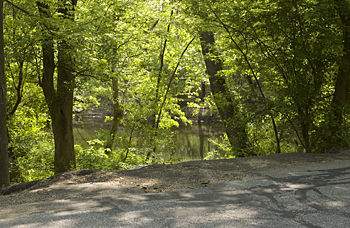Grades range from “A” for the large amount of open space in the watershed, to “B” for high dissolved oxygen levels, to “C” for declining macro-invertebrate populations. Macro-invertebrates are animals that have no backbone, but are visible to the naked eye. Those that live on stream bottoms are called benthic macro-invertebrates, and include aquatic insects such as mayflies and stoneflies.
The report was presented to more than 100 partners of the White Clay Creek Wild and Scenic River program during a celebration of the 40th anniversary of the National Wild and Scenic River Act held June 3 at the Deerfield Country Club. Issuing the report were Gerald Kauffman, project director and state water coordinator, and Martha Corrozi, assistant policy scientist, both in the UD Water Resources Agency (WRA).
WRA is part of UD's Institute for Public Administration in the College of Human Services, Education and Public Policy. The agency provides regional water resources planning, management and policy assistance to state and local governments and the public in Delaware and the Delaware Valley through its service education and research role at the University.
Complementing the University's strategic goal for leadership in environmental sustainability issues, the report--prepared for the U.S. National Park Service and the White Clay Creek Wild and Scenic River Management Committee--grades classifications that include landscape, hydrology, water quality and habitat.
The report notes that although the human population in the watershed has doubled over the past 30 years and that three square miles of open space have been lost over a decade, the water quality as measured by dissolved oxygen sediment and phosphorus has improved significantly over the last decade. State and local governments also have acquired nearly 20 square miles of parks and open space in the White Clay Valley since 1968.
While both Delaware and Pennsylvania stock 20 miles of streams with rainbow trout, some streams remain impaired by high levels of nitrogen, and fish consumption advisories remain in effect due to the high levels of PCB dumped in the streams prior to 1970.
The White Clay Creek is known as the only designated wild and scenic river in the United States based on a watershed basis instead of the typical river corridor basis. UD is one of relatively few Land Grant colleges to have a national wild and scenic river flowing through campus, providing a unique research and education laboratory for students and faculty.
Fish abundance surveys have counted more than two dozen fresh and saltwater fish in the creek, including brook trout, striped bass and American shad. The watershed also is home to more than 100 species of birds, including the neotropical migrant cerulean warbler and the recovering bald eagle.
During the spring semester, students in a UD Watershed Engineering course (CIEG 467) conducted field studies along the White Clay Creek and examined the feasibility of installing fish ladders at low dams to restore historic American shad runs.
Article by Jerry Rhodes
Photo by Jon Cox


